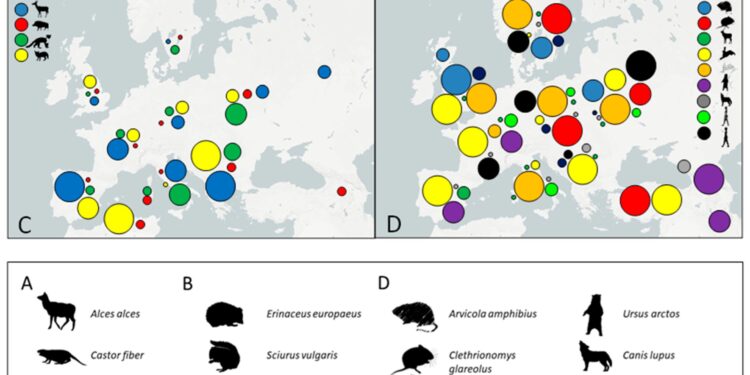Maps displaying the four main distribution patterns identified for private allelic richness identified after rarefaction at S = 10. (A) Decline in east-west variation; (B) West-central belt of greatest diversity; (C) Wealth of the South; and (D) Homogeneous without geographic pattern. Credit: Diversity (2024). DOI: 10.3390/d16100611
Humans appear to have adapted to the last ice age in the same way as wolves and bears, according to our recent study, challenging long-held theories about how and where our ancestors lived during that ice age.
Previous studies have supported the view of most archaeologists that modern humans retreated to southern Europe at the height of the last ice age and expanded during the subsequent rise in global temperatures . But our study is the first to use genetic data to show that at least some humans remained in central Europe, unlike many other animals and although our species evolved in the much warmer climate of Africa.
Scientists have known since the 19th century that the distribution of animals and plants around the world can fluctuate depending on climate. But the climate crisis has made understanding these fluctuations more important than ever.
Populations of the same species that live in different locations often have different genetics from each other. More recently, scientists have studied how climate change has altered the distribution of these populations of genetically distinct species.
Most studies in this area focus on individual species of animals or plants. They showed that many species, including humans, have expanded their geographic ranges since the height of the last ice age, around 20,000 years ago.
At this time, European ice sheets reached as far as Denmark and south Wales. Europe was cold but mostly unglaciated, probably much like Alaska or Siberia today.
Our team’s new study, led by Oxala García-Rodríguez of Bournemouth University, took a different approach and examined the genetic history of 23 common mammals in Europe. In addition to humans, these included rodents such as bank voles and red squirrels, insectivores such as shrews and hedgehogs, ungulates such as red deer and wild boar, and carnivores such as bears. brown and the weasel.
An important indicator of our study was where the greatest diversity is found in Europe today. Indeed, areas with high genetic variation are probably those where occupancy by species is the longest.
These areas, called refugia, are places where species retreated to survive during periods when environmental conditions were unfavorable elsewhere. For the mammals we studied, these refuges would have been occupied at least since the height of the last glaciation. These shelters were likely the warmer areas or places where it was easier for animals to find food.
The genetic patterns we found include cases where some mammals (such as red foxes and deer) were restricted to glacial refugia in southern regions like the Iberian Peninsula and Italy, and where they expanded from from these areas as global temperatures warmed after the ice age. Other mammals (such as beavers and lynx) expanded from glacial refuges in eastern Europe and then spread westward.
Species such as the pygmy shrew and common vole had been restricted to sheltered areas such as the deep valleys of northern Europe, small enclaves in otherwise inhospitable glacial landscapes. These patterns have already been documented by other scientists.
But we have found a fourth model. Our study indicated that some species (such as brown bears and wolves) were already widely distributed across Europe at the height of the last glaciation, either with no discernible refuges or with refuges both north and south. south.
This model also includes Homo sapiens. At that time, Neanderthals had already been extinct for around 20,000 years.
It is unclear why ancient humans and other animals in this group lived in this seemingly harsh climate rather than exploring more hospitable locations. But they seemed able to tolerate Ice Age conditions while other animals retreated to refuges.
Perhaps most importantly, among the species that appear to conform to this pattern, where little or no geographic population contraction took place at the height of the last ice age, are modern humans. It is particularly surprising that humans are part of this group, because our ancestors originated in Africa and it may seem unlikely that they were resilient to cold climates.
It is unclear whether these humans relied on ecological adaptation, for example the fact that they were omnivores meant they could eat many different things, or whether they survived thanks to technology. For example, it is well established that humans wore clothing, built homes, and controlled fire during the cold conditions of the last ice age.
This new model, and the inclusion of humans in this model, could lead scientists to rethink climate change and biogeography, particularly those studying changes in human distribution. This could mean that some areas could be habitable for longer than expected due to climate change.
More information:
Oxala García-Rodríguez et al, Contrasting patterns of genetic diversity in European mammals in the context of glacial refugia, Diversity (2024). DOI: 10.3390/d16100611
Provided by The Conversation
This article is republished from The Conversation under a Creative Commons license. Read the original article.
Quote: Ancient humans were so good at surviving the last ice age that they didn’t need to migrate like other species (2024, October 14) retrieved October 14, 2024 from
This document is subject to copyright. Except for fair use for private study or research purposes, no part may be reproduced without written permission. The content is provided for informational purposes only.



